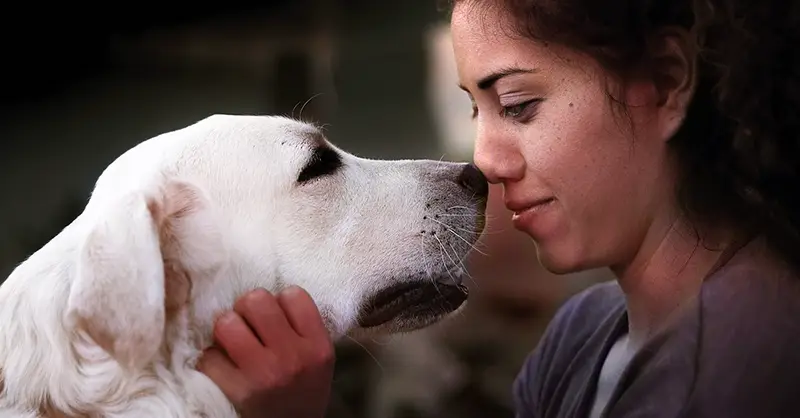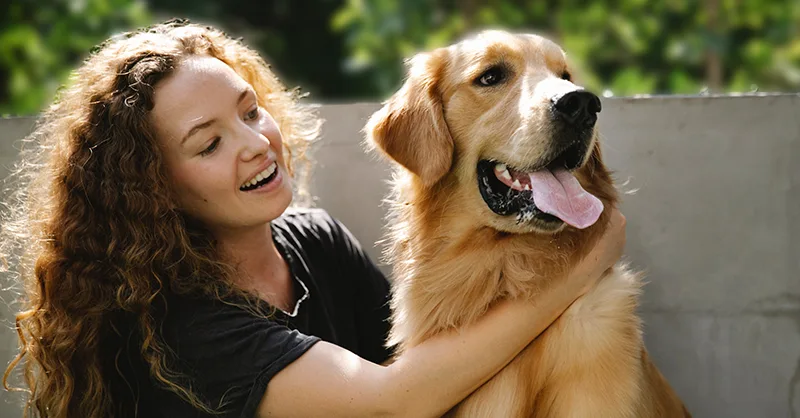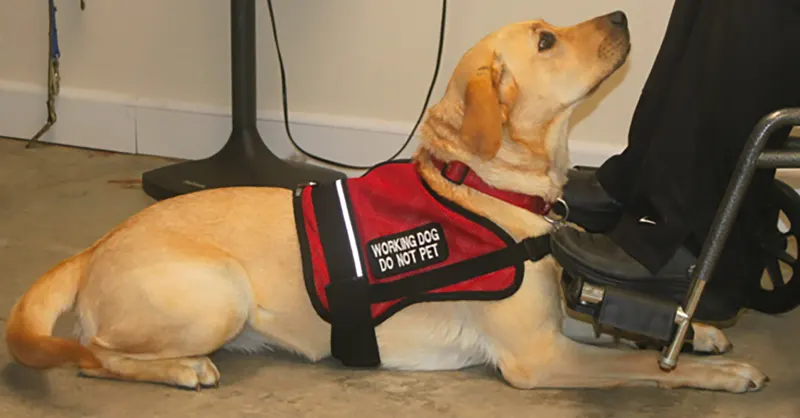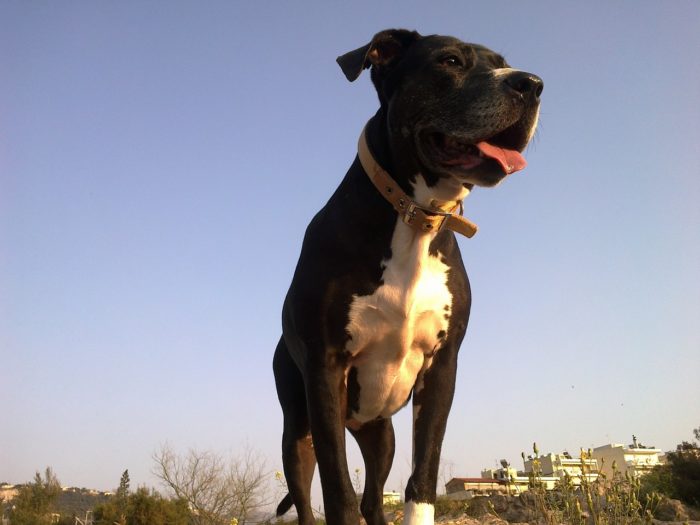Archive for the ‘Dogs’ Category
Dogs can have a beneficial impact on the people around them, whether they serve an individual as a service dog, provide support as an emotional support dog, or bring comfort as a therapy dog. Here are some of the differences between these types of dogs:
Service Dogs – Service dogs, defined under the ADA, are individually trained to work and perform tasks for a person with a disability. These dogs are covered under the ADA’s rights, meaning they can be brought into public establishments and live with their disabled owner even when a “no pets” policy is in place. Emotional Support Dogs – Emotional support dogs are the middle ground between service dogs and therapy dogs. These dogs provide emotional support through companionship and can be trained for a specific owner, but are not explicitly trained for people with disabilities. These dogs help relieve loneliness, depression, anxieties, and phobias. However, they are not covered under the ADA’s rights to bring animals into public establishments but can live with their disabled owner even if there is a “no pets” policy. Therapy Dogs – Therapy dogs bring emotional support through long-term care in places such as hospitals, retirement homes, schools, mental health institutions. These dogs are not covered under the ADA and are usually brought into institutions through a non-profit organization. Therapy dogs can handle various environments and bring comfort to many people in clinical, and learning settings and typically are trained, licensed, and insured under an organization.
Hence, the validation of what constitutes a therapy dog has a specific definition, but in regards to legal rights, those rights can vary. According to the Journal of Environmental Research and Public Health, there is a lack of objective data regarding the public’s ability to understand these animal’s roles as well as the animal’s legitimacy concerning rules and regulations overlooking them. Governing documents and company policies all have different definitions of therapy dogs and how they interact with public spaces. The JERPH states that no specific laws governing therapy animals. Thus, this leaves the rules regarding therapy animals lacking in definition and can also lead to loopholes about how therapy dogs interact with the world.
What do laws and policies state about Therapy Dogs? According to the Fair Housing Act, the act follows the ADA guidelines regarding service animals and thus uses the term “assistance animal” as a way to ensure housing providers of their obligations, labeling the terms “service animal,” “support animals” and “therapy animals” within that definition. While the FHA defines therapy dogs under the term “assistance,” the FHA allows housing providers to refuse access for therapy dogs onto their property but will allow service dogs to gain access to public spaces because of their rights under the ADA. Emotional support animals have access to housing, in spite of no-pets policies under the FHA.
In the state of New York, a report issued in 2018, concluded that there are no national or statewide standards regarding training, evaluation, certification, and identification of therapy dogs. It also states that there is “confusion regarding the rights and responsibilities of [owners of] therapy dogs [and] emotional support dogs.” Hence, in its conclusion, it states that it recommends the development of those standards so it can benefit the public, their dogs, and organizations, also suggesting that therapy dogs should be licensed and identified by therapy dog tags and other accessories and should have liability insurance as part of their coverage. Another organization, Assistance Dogs International, follows the ADA guidelines in regards to service animals, but does not explicitly define the difference between service, emotional support, and therapy dogs, also using the classification assistance dogs as an overarching term. The ADI’s standards apply more so to people with disabilities, stating that whether the disability is physical or mental, the animal must be individually trained for specific tasks for that person to be considered a service dog and be given ADA rights. Thus, the ADI only provides training standards for service animal trainers and organizations, excluding emotional support dogs and therapy dogs from those standards. Unlike governing policies and accreditation organizations, companies like IHOP help define therapy dogs and the boundaries for these kinds of assistance animals. According to IHOP’s policy, therapy dogs are trained, certified, and insured to work in institutions to help educate a community, provide comfort, and act as animal ambassadors for their local community. They also state that therapy dogs do not fall under the ADA regulation and have no rights to public access. Hence, if a therapy dog were to try and gain public access to an IHOP restaurant, they would not be allowed to unless otherwise allowed by the owner of the establishment.
How can Therapy Dogs get certified?The American Kennel Club, while does not certify therapy dogs, provides their training programs for organizations to use to be able to verify their dog as a therapy dog. The Canine Good Citizen (CGC) is considered to be a prerequisite, which includes the 10-step CGC test as a way for their dogs to get acquainted with basic dog training requirements. The AKC also offers title awards in their AKC Therapy Dog™ program, which allows the organization to recognize dogs for excellent service and meet requirements needed by their AKC approved training organization.
Approved organizations, such as Alliance of Therapy Dogs, have their own set of standards for those wishing to turn their dogs into therapy dogs, which includes finding a certified tester to test the dog’s basic training and demeanor. Once the dog goes through a few test runs supervised by the examiner in medical facilities, the person can apply and approve their animal. ATD members then must follow the organization’s guidelines, which includes the ATD providing liability insurance, dog health requirements, grooming requirements, dog equipment, and safety precautions.
If you would like to register your therapy dog online, you may do so here. You can also order your identification card and therapy dog vest while registering your therapy animal. Although not legally required, having a therapy animal identification card and vest can be useful when identifying your animal as a therapy animal in public.
Can my dog become a Therapy Dog?Therapy dogs can be any breed of dog, as the primary purpose of therapy dogs is to provide people with companionship and comfort. Hence, therapy dogs must be able to enjoy the company of people of all ages and be comfortable being touched. The AKC has their own outlined qualities, including:
The dog must have an undiscriminating love for the people he/she meets Have a willingness to meet new people Have a calm demeanor Have a high tolerance for physical discomfort Must not get easily scared by loud noises and sudden movementsWhen it comes to therapy dogs in public spaces, therapy dogs can only be allowed in open areas when that public space has a therapy dog program or is permitted by the official representative of that organization/company, according to the ATD. Because these dogs can bring support in care and education facilities, therapy dogs can They also states that the presence of a therapy dog can be overall beneficial to the people around them. The ATD says that animal-assisted therapy helps people relax by releasing serotonin, prolactin, and oxytocin in the brain, reducing loneliness, providing comfort, and creating a distraction as a result. Physically, therapy dogs can lower blood pressure, diminish physical pain, motivate people, and help with social interaction. Because these dogs are not generally allocated to a disabled owner, these dogs can be specially trained to support more than one person through any situation.
There are approximately 18 million Pit Bull-type dogs in the United States, (or 20% of the dog population). The “Pit Bull,” however, is not a definitive breed, but rather a catch-all term for any dog that exhibits the appearance of this bully breed (not necessarily its genetic makeup).
In general, there are four breeds widely referred to as the “Pit Bull.” These include; the American Pit Bull Terrier, American Staffordshire Terrier, American Bully, and the Staffordshire Bull Terrier.
These breeds are similar and do share some common characteristics, which could be why they are commonly confused for one another.
In this post, we will explore the American Pit Bull and answer the question of; can a Pit Bull be a Service Dog?
General Traits of the American Pit BullUnfortunately, over the years, unscrupulous people have given the “Pit Bull” a bad name. These dogs have gained the reputation for being vicious killers out for blood. Nothing could be further from the truth.
A well-bred “Pit Bull” is friendly, loving, and a devoted companion. They have no idea of their size and believe that any lap is an opportunity for love and affection.
Although the Pitty is very keen on its surroundings, it does not make a good watchdog. Yes, the Pit Bull will alert you to someone at your door, but only because it is eager to greet its “guests.”
The Pit Bull is a sturdy, energetic dog, that is very tolerant of children. However, as with any dog, early socialization and exposure to different sights, sounds, people, and other dogs is highly recommended.
Because of its need for love and affection, the American Pit Bull does not do well when left alone for extended periods-of-time.
American Pit Bull Terriers have a great need to chew. They also have powerful jaws that can (and will) make quick work of cheap or flimsy toys. Be sure your Pitty has only tough, durable toys that can’t be chewed up and swallowed.
American Pit Bull Terriers are best suited to owners who can offer firm, fair training, and gentle, consistent discipline.
Fast Facts About the American Pit Bull
Height: Up to 19 inches at the shoulder
Weight: 30 to 85 pounds
Lifespan: 12 to 16 years
Characteristics: Pit Bulls are known for their loyalty and eagerness to please. This makes them a wonderful candidate to be trained as a service animal.
The American Pit Bull as a Service DogDespite the stigma attached to the Pit Bull, they do make excellent Service Dogs. They are large enough and strong enough to pull a wheelchair, as well as offer physical support for those with balance or mobility issues.
Their loyal, dedicated, and intuitive nature makes them a natural for offering emotional or physical comfort for those individuals with psychological or psychiatric conditions like PTSD, depression, or social anxieties.
The American Pit Bull can also be trained to be a Medical Alert Service Dog. These animals respond to various health issues such as low blood sugar, oncoming seizures, or low oxygen levels. They can also be trained to remind people to take their medications.
Click here to Register your Service Dog Breed Legislation and the Pit Bull BreedsDue to the misconceptions of the Pit Bull breeds, many regions have imposed a ban on owning these dogs. However, according to the Fair Housing Act, it is illegal to discriminate against a person owning a Pitty breed when it is used as a Service Dog.
There are also two organizations on a mission to change the stigma of the Pit Bull breeds.
The Animal Farm Foundation’s Assistance Dog Training Program (New York) trains shelter Pit Bulls to push wheelchairs and to help people regain their mobility and avoid falls. It’s believed to be the only American training school that exclusively trains shelter Pit Bulls to be service dogs.
Another group in Chicago, Pits for Patriots, trains rescued Pit Bulls as comfort, therapy, and support dogs for veterans, police officers, and firefighters. The organization’s co-founder, Kelly Yearwood, says;
“veterans and first responders identify with bully breeds because they’ve both seen a lot of trauma.”
Can an American Pit Bull Be a Service Dog?
The American Pit Bull (and all the Pitty breeds) can make excellent Service Dogs. However, like any other dog, early socialization, proper training, and positive reinforcement all work together to create a well-rounded canine.
Service dogs are entitled to public access rights with their handler. This means that you and your service dog can go anywhere that you are allowed to go – like office buildings, stores, no-pet apartments, etc.
If you think a Pit Bull is a breed that will work best for your disability, be sure to seek out a reputable breeder or rescue organization. Get all the information you can on the specific dog, then go to work training it up in the ways of service.
You will be happy you did.
The Yorkshire Terrier is a big dog in a small package. With his silky coat and traditional “topknot,” the Yorkie is sure to attract attention wherever he goes. And because of his pint-size, this dog often travels in style – in designer doggy purses or special totes made just for those “elite” pooches.
The Yorkie may have won the hearts of those looking for some “furry arm candy” but what about in the world of service? Can a Yorkie be a Service Dog? According to the Americans with Disability Act (ADA), any breed of dog can be a service dog.
Ready to register your Service Dog Yorkie? Complete the service dog registration in the link below.
General Traits of the YorkieThe Yorkie is a curious and playful pooch that is always on the lookout for a new adventure (and maybe even some trouble). This breed is affectionate towards his people, yet he can also be a bit wary of strangers, barking at unfamiliar sounds and “intruders.”
Despite his propensity for being a watchdog, the Yorkie does need time with his family and won’t do well left alone for long periods-of-time.
The Yorkie is also a very intuitive breed. He will pick up on his owner’s feelings so be aware not to over-coddle your pup, or he may start to believe the world is a scary place and react with fear.
Since the Yorkshire doesn’t grow very large, it’s best to keep small children away from this dog. They can become snappish if startled or teased.
The Yorkie adapts well to apartment and condo living as he doesn’t need excessive exercise. It is also considered to be hypoallergenic since his long coat is more like hair than fur.
Fast Facts About the YorkieHeight: Up to 9 inches at the shoulder
Weight: 4 to 6 pounds
Lifespan: 12 to 15 years
Yorkshire Terriers as a Service Dog?For obvious reasons, the Yorkie would not do well for people that need a Service Dog for large tasks such as pulling a wheelchair or providing balance support. However, that doesn’t mean your Yorkie is out of the picture.
Even though they are small, Yorkies can still be adept at helping around the house with more managable projects. These include pulling open cabinet doors equipped with soft handles, fetching the television remote, retrieving clean clothes from the dryer, and alerting their owners to specific sounds such as the telephone ringing, the doorbell or a crying baby.
Yorkies have even proven themselves to be valuable as a medical alert service animal. They can be trained to detect epileptic seizures and subtle changes in a diabetic’s glucose level.
This breed is also valuable for those individuals that suffer from specific psychiatric issues. Their small stature allows them to accompany their handlers almost anywhere, which can be a huge advantage for some people suffering from a mental illness.
Another area a Yorkie can be used as a Service Dog is lap duty. This is perfect for tinier breeds (like the Yorkie) which provides caregivers the opportunity to physically embrace their canine companions rather than having just the dog’s head resting on their laps.
What to Look for in a Potential Service DogRegardless of the breed of dog, there are some qualities and characteristics a good Service Dog should possess. These include;
Being the right size, with the right amount of strength, and stamina to perform the duties. The canine must be physically active as well as calm when in public. The dog will need to have a certain amount of Intelligence and obedience and will need to problem-solve. Must always be well-behaved in public situations. Not hyper, snappy or creating a ruckus. Can My Yorkie Be a Service Dog?Although the Yorkie is a small breed, there are many Service Dog tasks he is capable of learning. These include being there for physiatric issues and small duties around the home, like opening cabinet doors.
If you have a disability and believe a Yorkie may be the right choice for you, then be sure to seek out a reputable breeder or a rescue organization.
Getting back to living a healthy life may be closer than you think.







